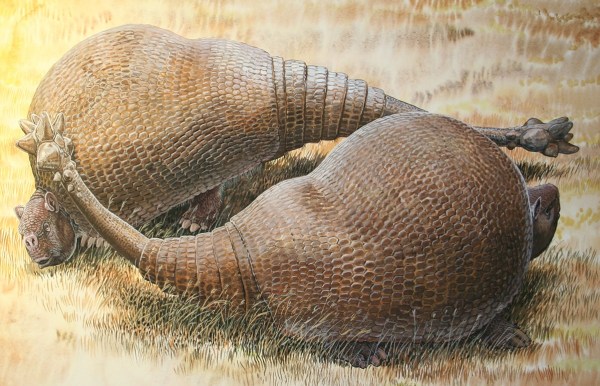By Ana Verayo, | February 23, 2016

Gylptodonts are ancient armadillos that were the size of a small car.
For the first time ever, scientists have decoded the genome of a giant armadillo-like mammal that roamed the grasslands of South America millions of years ago, as they disappeared mysteriously during the last Ice Age.
Like Us on Facebook
These ancient mammals are known as glyptodonts which are roughly the size of Volkswagen Beetle, that is also estimated to weigh more than a ton. These armadillo ancestors possess a heavy club connected at the end of their tails that scientists believe that were used to swing hard at potential predators and mate rivals, when these hostile creatures get too close.
What makes this ancient creature unique is its armor-like shell that is also present in the modern day, smaller armadillo. However, instead of segments building up this armor, the glyptodont's shell is apparently segments that are molded into one entire carapace. DNA were scraped from the fossilized fragments of a specimen's armored plate which helped scientists decode the giant armadaillo's whole mitochondrial genome, which is non chromosomal DNA that are inherited from its maternal lineage.
In this new study, analysis of this mitochondrial DNA revealed how this peculiar animal have been thriving for millions of years before it was wiped out which is also more closely related to modern day armadillos that are so small and have a leather coat.
According to Frederic Delsuc from the National Centrer for Scientific Research in France, glyptodonts can be classified as a subfamily consisting of gigantic armadillos. The team believes that this odd structure made from an unarticulated carapace could be the evoluionary response to function constraint as their sizes increased over time.
The results revealed that glyptodonts most likely separated from the last common ancestor that armadillos shared with them some 35 million years ago.
According to evolutionary geneticist, Hendrik Poinar from the McMaster Ancient DNA Center in Ontario, Canada, this new data reveals much about familial relations of this oddly charismatic creature that was always been a mystery, whether the glyptodont was a gigantic armadillo or another creature that had a similar carapace exoskeleton.
Poinar adds how crucial it is to study ancient DNA to solve evolutionary relationships of extinct mammals depending on the availability of usable DNA from fossilized specimens.
This new study is published in the journal Current Biology.
-
Use of Coronavirus Pandemic Drones Raises Privacy Concerns: Drones Spread Fear, Local Officials Say

-
Coronavirus Hampers The Delivery Of Lockheed Martin F-35 Stealth Fighters For 2020

-
Instagram Speeds Up Plans to Add Account Memorialization Feature Due to COVID-19 Deaths

-
NASA: Perseverance Plans to Bring 'Mars Rock' to Earth in 2031

-
600 Dead And 3,000 In The Hospital as Iranians Believed Drinking High-Concentrations of Alcohol Can Cure The Coronavirus

-
600 Dead And 3,000 In The Hospital as Iranians Believed Drinking High-Concentrations of Alcohol Can Cure The Coronavirus

-
COVID-19: Doctors, Nurses Use Virtual Reality to Learn New Skills in Treating Coronavirus Patients







